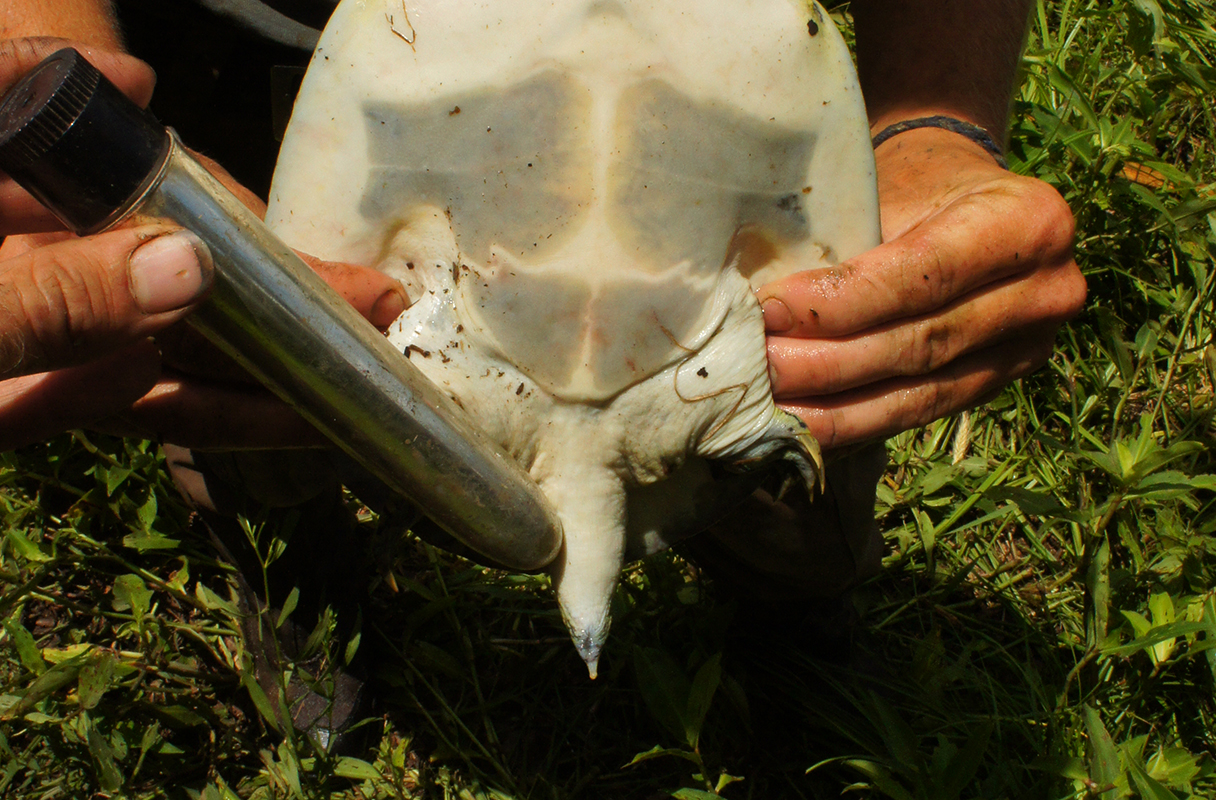For Some Turtles, Science Is a Real Turn-On

When scientists collect or observe animals in the wild, it sometimes can be extremely challenging to identify their sex. But a group of researchers recently found an innovative and relatively simple way to determine the sex of turtles in the field, coaxing reluctant males into, um, revealing themselves, through the judicious application of a vibrator.
They put four turtle species to a new and titillating test, applying their turtle tickler — a 7-inch-long (18 centimeters), handheld vibrator — to the nether regions of western chicken turtles (Deirochelys reticularia miaria), Mississippi mud turtles (Kinosternon subrubrum hippocrepis), common musk turtles (Sternotherus odoratus) and spiny softshell turtles (Apalone spinifera).
And while there were varying degrees of success between the species, the researchers reported in a new study that plenty of the turtle males obligingly rose to the occasion. [The 9 Weirdest Animal Penises]
In some turtle species, it can be difficult to tell the sexes apart just by looking at them. Either the males and females aren't very different in size or body shape, or the individual turtles exhibit secondary sex traits that belong to both males and females, the study authors reported.
And traditional methods for distinguishing turtle sexes — such as sampling blood for sex hormone analysis, minor surgery, or camera insertion into their genital areas — are time-consuming and invasive, and tricky to perform outside of a laboratory's controlled environment, study lead author Donald McKnight, a doctoral candidate with the College of Marine and Environmental Sciences at James Cook University in Australia, told Live Science in an email.
"Although this is an admittedly comical method, it does actually have scientific merit because it is less invasive for the animals and easier and cheaper for the researchers," McKnight said.
Lending a hand
This isn't the first time that scientists have experimented with stimulating male turtles to tell the sexes apart. Earlier efforts found that Cotinga River toadhead turtles (Phrynops tuberosus) would become erect if their limbs and neck were immobilized, while common snapping turtles (Chelydra serpentina) would show their penises if they were gently bounced up and down, the study authors wrote.
Sign up for the Live Science daily newsletter now
Get the world’s most fascinating discoveries delivered straight to your inbox.
And a prior study used vibrators on male turtles to make them ejaculate, which suggested that vibrators could shake things up for field researchers trying to induce turtle erections.
Using the vibrator, the scientists correctly identified the sex of 100 percent of their A. spinifera turtles and 80 percent of K. subrubrum hippocrepis, according to the study. The other two species were somewhat less responsive, enabling the scientists to identify the sex of about 65 percent of their D. reticularia miaria turtles and 56 percent of S. odoratus.
All four turtle species in the study seemed to prefer the vibrator at its highest setting and with fresh batteries, according to McKnight. However, distinct preferences among the species also emerged.
Spiny softshell turtles appeared to enjoy having their tails stimulated, frequently wagging them "from side to side," the study authors reported. Meanwhile, Mississippi mud turtles and musk turtles were most responsive to "slow, small circles" on their abdominal and pectoral regions. Western chicken turtles also enjoyed the circular movements, but higher up on their pectorals, according to the researchers.
Previous research suggested that male turtles could be coaxed into ejaculating with the application of a vibrator to their heads. The study authors dutifully tested that technique, but found that it generally left their turtles unimpressed, adding to their conclusion that not all vibration methods work equally well across species.
"The best future directions would be to try several different styles of vibrator to see if some are more effective than others, as well as to test this method on a wider range of species — especially species that are known to be difficult to sex," McKnight told Live Science.
In other words: Different folks need different strokes. Even when those folks are turtles.
The findings were published online in the June 2017 issue of the journal Acta Herpetologica.
Original article on Live Science.

Mindy Weisberger is an editor at Scholastic and a former Live Science channel editor and senior writer. She has reported on general science, covering climate change, paleontology, biology and space. Mindy studied film at Columbia University; prior to Live Science she produced, wrote and directed media for the American Museum of Natural History in New York City. Her videos about dinosaurs, astrophysics, biodiversity and evolution appear in museums and science centers worldwide, earning awards such as the CINE Golden Eagle and the Communicator Award of Excellence. Her writing has also appeared in Scientific American, The Washington Post and How It Works Magazine. Her book "Rise of the Zombie Bugs: The Surprising Science of Parasitic Mind Control" will be published in spring 2025 by Johns Hopkins University Press.









